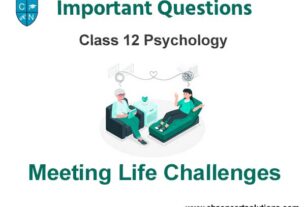Students can read the important questions given below for Dual Nature of Radiation and Matter Class 12 Physics. All Dual Nature of Radiation and Matter Class 12 Notes and questions with solutions have been prepared based on the latest syllabus and examination guidelines issued by CBSE, NCERT and KVS. You should read all notes provided by us and Class 12 Physics Important Questions provided for all chapters to get better marks in examinations. Physics Question Bank Class 12 is available on our website for free download in PDF.
Important Questions of Dual Nature of Radiation and Matter Class 12
Question. Assertion: A photon has no rest mass , yet it carries definite momentum.
Reason: Momentum of photon is due to its energy and hence its equivalent mass.
(a)A
(b)B
(c)C
(d)D
Answer
A
Question. Assertion: Photoelectric effect demonstrates the wave nature of light.
Reason. The number of photoelectrons is proportional to the frequency of light.
(a)A
(b)B
(c)C
(d)D
Answer
D
Question. Assertion:When acertain wavelength of light falls on a metal surface it ejects electron.
Reason. Light has wave nature.
(a)A
(b)B
(c)C
(d)D
Answer
B
Question. Assertion. The de-Broglie wavelength of a neutron when its kinetic energy is k is λ. Its wavelength is 2 λ when its kinetic energy is 4k. Reason. The de – Broglie wavelength λ is proportional to square root of the kinetic energy.
(a)A
(b)B
(c)C
(d)D
Answer
D
Question. Assertion. The de – Broglie wavelength of a molecule varies inversely as the square root of temperature.
Reason. The root mean square velocity of the molecule depends on the temperature.
(a)A
(b)B
(c)C
(d)D
Answer
A
Question. Assertion: The de Broglie equation has significance for any microscopic or sub-microscopic particlea.
Reason: The de Broglie wavelength is inversely proportional to the mass of the object if velocity is constant.
(a)A
(b)B
(c)C
(d)D
Answer
A
Question. Assertion : A particle of mass M at rest decay into particles of masses m1 and m2,having non-zero velocities will have ratio of de-Broglie wavelengths unity.
Reason. Here we cannot apply conservation of linear momentum.
(a)A
(b)B
(c)C
(d)D
Answer
A
Question. Assertion: As work function of a material increases by some mechanism, it requires greater energy to excite the electrons from its surface.
Reason. A plot of stopping potential (V2) versus frequency (v) for different materials,has greater slope for metals with greater work functions.
(a)A
(b)B
(c)C
(d)D
Answer
C
Question . Assertion : Light of frequency 1.5 times the threshold frequency is incident on photo-sensitive material.If the frequency is halved and intensity is doubled the photo current remains unchanged.
Reason.The photo electric current varies directly with the intensity of light and frequency of light.
(a)A
(b)B
(c)C
(d) D
Answer
D
Question. Assertion: Mass of moving photon varies inversely as the wavelength. Reason: Energy of the particle = mass x (speed of light)2
(a)A
(b)B
(c)C
(d)D
Answer
A
Question. Assertion: In photoelectron emission, the velocity of electron ejected from near the surface is larger than that coming from interior of metal.
Reason. The velocity of ejected electron will be zero.
(a)A
(b)B
(c)C
(d)D
Answer
C
Question. Assertion: A photocell is called an electric eye.
Reason. When light is incident on some semiconductor, its electrical resistance is reduced .
(a)A
(b)B
(c)C
(d)D
Answer
C
Question. Which of the following waves can produce photo electric effect
(a). UV radiation
(b). Infrared radiation
(c). Radio waves
(d) .Microwaves
Answer
A
Question. Work function of alkali metals is
(a)less than zero
(b)just equal to other metals
(c) greater than other metals
(d) quite less than other metals
Answer
D
Question. Packet of energy are called
(a)electron
(b)quanta
(c)frequency
(d)neutron
Answer
B
Question. One quantum of radiation is called
(a)meter
(b)meson
(c) photon
(d)quark
Answer
C
Question. Energy associated with each photon
(a)hc
(b)mc
(c)hv
(d)hk
Answer
C
Question. One quantum of radiation is called
(a)meter
(b)meson
(c) photon
(d)quark
Answer
C
Question. If an electron and proton are propagating in the form of waves having the same λ , it implies that they have the same
(a)energy
(b)momentum
(c)velocity
(d)angular momentum
Answer
b
Question. Moving with the same velocity , which of the following has the longest de Broglie wavelength?
(a)ᵦ -particle
(b) α -particle
(c) proton
(d) neutron.
Answer
b
Question.The dual nature of light is exhibited by
(a) diffraction and photo electric effect
(b) photoelectric effect
(c) refraction and interference
(d)diffraction and reflection.
Answer
A
Question. If the momentum of a particle is doubled , then its de-Broglie wavelength will
(a)remain unchanged
(b)become four times
(c) become two times
(d)become half
Answer
D
Question. Velocity of a body of mass m, having de-Broglie wavelength λ , is given by relation
(a) v = λ h/m
(b) v = λm/h
(c) v = λ/hm
(d) v = h/ λm
Answer
D



